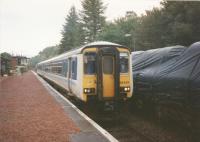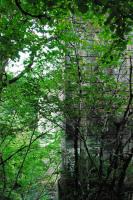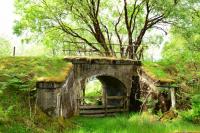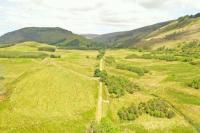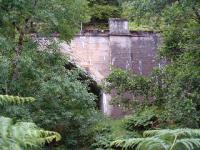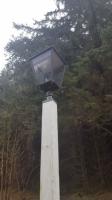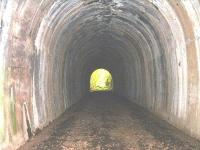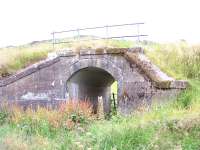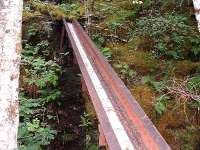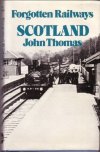Invergarry and Fort Augustus Railway
Introduction
This line is closed. The railway ran 24 miles from Spean Bridge on the West Highland Railway to Fort Augustus. For much of its length it followed the Great Glen. It was conceived as being the first part of a new route to Inverness from the south. Construction was expensive and it was built to a high standard with fine castellated viaducts and large stations. Like the Mallaig line concrete was used in its construction. The first sod was cut in 1897. The line had a very chequered early history, for a time making more money closed than open, before becoming a branch of the West Highland Railway until closing after the Second World War. Despite the long closure much of the route remains obvious and much of the trackbed is walkable and carries an official walking route, the Great Glen Way . John Thomas, in Forgotten Railways: Scotland, described its remains best, alluding to Robert Burns' A Red, Red Rose:
The Invergarry & Fort Augustus Railway, carved out of the mountain slopes, will be there until the rocks melt with the sun.
Dates
| 14/08/1896 | Invergarry and Fort Augustus Railway Act passed. Proposed by Charles Forman. |
| / /1897 | Invergarry and Fort Augustus Railway Bill proposing extension from Fort Augustus to Inverness is rejected in the House of Commons. |
| 02/02/1897 | Invergarry and Fort Augustus Railway First sod cut by Eliza Stewart Ellice, second wife of Edward Ellice [Junior] deputy chairman of the line. |
| / /1900 | Invergarry and Fort Augustus Railway Authorised to make arrangements to have North British Railway work the line. |
| / /1901 | Invergarry and Fort Augustus Railway Extension of time to complete line granted. |
| / /1901 | West Highland Railway Invergarry and Fort Augustus Railway Original signal box at Spean Bridge closed and replaced along with the opening of a junction signal box, a subsidiary to the main box. |
| 06/03/1902 | Invergarry and Fort Augustus Railway Working agreement with Highland Railway drawn up. |
| 14/07/1903 | Invergarry and Fort Augustus Railway Final inspection by the Board of Trade. |
| 21/07/1903 | Highland RailwayInvergarry and Fort Augustus Railway Act passed which allows the Highland Railway to operate the services over the Fort Augustus line. |
| 22/07/1903 | Invergarry and Fort Augustus Railway
Highland Railway Line opened by Eliza Stewart Ellice of Invergarry House. The service was operated by the Highland Railway who were keen to keep the North British Railway away from Inverness. Connecting David Hutcheson and Co steamers operating along the Caledonian Canal connecting the line to Inverness via Loch Ness and the canal. Stations opened at Gairlochy, Invergarry, Aberchalder, Fort Augustus and Fort Augustus Pier. The Lovat Arms and Station Hotel was rebuilt and reopened in connection with new line. |
| 01/07/1904 | Invergarry and Fort Augustus Railway Invergloy Platform opened. |
| /03/1906 | Invergarry and Fort Augustus Railway Line re-opened following flood damage. |
| 30/09/1906 | Invergarry and Fort Augustus Railway Fort Augustus Pier station and line to Fort Augustus station closed. |
| 12/04/1907 | Invergarry and Fort Augustus Railway Discussions of working agreement with North British Railway begin. |
| 30/04/1907 | Invergarry and Fort Augustus RailwayHighland Railway Highland Railway withdraws locomotives and rolling stock from the Invergarry line and ceases its operation. |
| 01/05/1907 | Invergarry and Fort Augustus RailwayNorth British Railway North British Railway start running service. Working agreement confirmed with the company. |
| 31/10/1911 | Invergarry and Fort Augustus RailwayNorth British Railway Line closed to all traffic as North British Railway withdraws. |
| 04/08/1913 | Invergarry and Fort Augustus Railway Purchased by North British Railway who re-open the line. |
| 28/08/1914 | Invergarry and Fort Augustus Railway
North British Railway North British Railway (Invergarry and Fort Augustus) vesting and confirmation Act passed as the North British Railway prepares to buy the line. (Or 24/08/1914.) |
| 31/12/1914 | Invergarry and Fort Augustus RailwayNorth British Railway North British Railway buys line and railway hotel (Lovat Arms and Station Hotel) at Fort Augustus. |
| 20/09/1921 | West Highland Railway Invergarry and Fort Augustus Railway Spean Bridge junction signal box closed, junction rationalised. |
| /08/1924 | Invergarry and Fort Augustus Railway Two coaches of a train derail near Gairlochy as a result of flood damage. |
| /03/1926 | Invergarry and Fort Augustus Railway Landslide at Corriegour and five landslides west of Invergarry station. A ballast train with men to clear the obstruction was caught between two of the rockfalls. |
| /05/1927 | West Highland Railway Invergarry and Fort Augustus Railway Mallaig Extension (West Highland Railway) All three lines closed during gales. |
| 01/12/1933 | Invergarry and Fort Augustus Railway Fort Augustus to Spean Bridge closed to passengers. Gairlochy, Invergarry, Invergloy Platform, Aberchalder, Fort Augustus closed. Line closed to all but a weekly coal train. (Also given as 31/12/1933). |
| / /1939 | Invergarry and Fort Augustus Railway During World War II a goods train runs every day in connection with logging activities. |
| / /1945 | Invergarry and Fort Augustus Railway Withdrawal of daily freight train. |
| 14/04/1946 | West Highland Railway Invergarry and Fort Augustus Railway Spean Bridge signal box closed and temporary box opened. |
| 31/12/1946 | Invergarry and Fort Augustus Railway Line closed and track lifting commences shortly afterwards. |
| 01/01/1947 | Invergarry and Fort Augustus Railway Fort Augustus to Spean Bridge (excluded) closed to freight. |
| 28/03/1947 | Invergarry and Fort Augustus Railway One coach special run for prospective hiring (by a timber merchant). Line not hired. |
| /10/1948 | Invergarry and Fort Augustus Railway Track lifting begins from Fort Augustus. |
| /03/1950 | Invergarry and Fort Augustus Railway Last section of the line dismantled, except for a short length retained as a siding at Spean Bridge. |
| 30/10/1950 | Invergarry and Fort Augustus Railway Fort Augustus station burned down. |
| / /1958 | Invergarry and Fort Augustus Railway A82 bridge over the line at Glenfintaig demolished. |
Route described
This was a 24 mile railway running from Spean Bridge, on the West Highland Railway, to Fort Augustus at the south end of Loch Long.
Leaving Spean Bridge the line turned from west to north west dropping slightly to cross the River Spean by the Spean Viaduct [IFA]. It then ran on a shelf above the east bank of the river passing General Wade's High Bridge. The modern day road north took a different route north, climbing hard on the western slopes of Coire Ceirsle Hill, passing the Commando Monument.
Gairlochy station served the village, below and off to the west, and, more distantly, Achnacarry House, further off to the west.
After passing the station the line turned away from the Spean to enter Glen Albyn, the Great Glen, running above the east side of the south end of Loch Lochy, with distant view of Achnacarry House off to the west, before turning inland to meet the road north, cross it and then run parallel in a cramped gully to reach the Gloy Viaduct.
From the Gloy Viaduct the line continued to Invergloy Platform, far above Invergloy House which is to the west on the east bank of Loch Lochy.
The line continued above the loch, with the road slowly dropping down to its shore and the line reaching its summit at Letterfinlay Crossing, a passing place which never opened. Letterfinlay Lodge Hotel is below and above, so the south east, is the summit of Leitir Fhionlaigh. Across the loch are views of Meall na Teanga and Sron a Choire Chairbh.
The line progressively lost height, passing a little to the east of the Laggan Locks at the north end of Loch Lochy.
Invergarry station was next which served, distantly, the village of the same name and Invergarry House. Much more distantly it served Glenquoich Lodge, seat of Lord Burton who was the driving force behind the railway's development.
After Invergarry, a the south end of Loch Oich, the road north takes to the west side of the loch and the railway and General Wade's road continue north up the east side. Around half way up the loch Invergarry House can be seen on the west side.
At the north end of the loch the railway passed through the Loch Oich Tunnel and shortly afterwards crossed the Calder Burn Viaduct before passing Abercalder Lodge, off to the east.
From Abercalder station the line was largely level, running parallel with the road north into Fort Augustus, on the west side of the village and south of the Caledonian Canal.
A short line extended north from Fort Augustus, crossing the Caledonian Canal by means of Fort Augustus Swing Bridge west of a ladder of locks and quickly followed by crossing the River Oich by the Oich Viaduct. The line then swung east with a view of the Fort Augustus Abbey to the south and past Battery Rock, to the north, to reach the west shore of Loch Ness at its southern end.
Fort Augustus Pier station was reached shortly afterwards terminating next to a steamer pier on the west side of the loch. Inverness is around 30 miles distant, to the north. Steamers traversing the Caledonian Canal between Fort William and Inverness could be used to continue the journey north.
Locations along the line
These locations are along the line.
This is a two platform station with a passing loop. The main station building on the eastbound platform (for the south), altered at the road side, remains standing. There is a disused signal box ('C' listed) dating from 1949.
...
See also
West Highland Railway
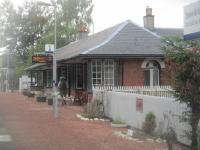
David Bosher 07/09/2022
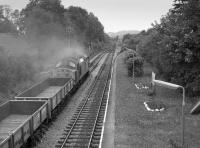
Bill Roberton //1984
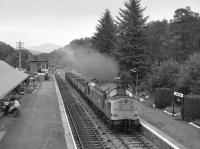
Bill Roberton //1984
Array
More detailsThis was a girder viaduct over the River Spean close to the junction at Spean Bridge station.
...
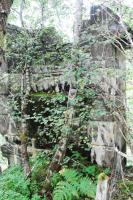
Ewan Crawford 21/09/2008
This was an island platform station with a building typical of the line. There was a signal box to the south of the station building and a generous goods yard, (four sidings, and loading banks for animals and goods), laid out on the east side. Access to the platform was by a ramp from a road overbridge.
...
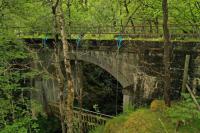
John Gray 08/06/2023
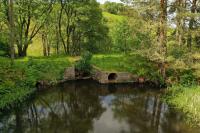
John Gray 08/06/2023
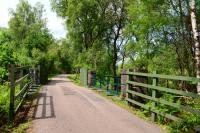
John Gray 08/06/2023
This viaduct crossed the River Gloy between Invergloy Platform and Gairlochy. To the south the railway ran on a shelf between the road north, to the west, and river.
...
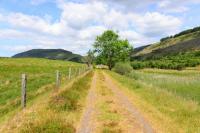
John Gray 08/06/2023

Ewan Crawford //1996
Array
More details...
More details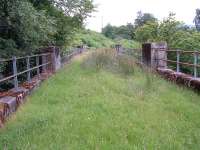
John Gray //
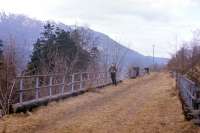
Frank Spaven Collection (Courtesy David Spaven) //1966
This passing loop was high above the east bank of Loch Lochy, above Letterfinlay Lodge.
...
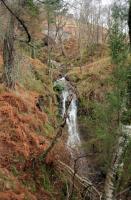
Ewan Crawford //1996
This was an island platform station with a building similar to those on the West Highland Railway. The building's canopy on the west side extended over the down loop, due to the proximity of Invergarry House. The portion over the loop was cut back in later years. The signal box was north of the station building. Invergarry station was 15 miles from the junction with the [[West Highland ...
More details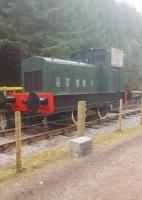
John Yellowlees 02/04/2017
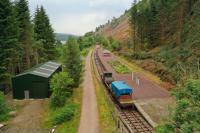
John Gray 13/06/2023
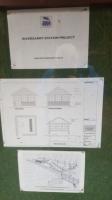
John Yellowlees 02/04/2017
This is a disused single track tunnel 201 ft long on the east side of Loch Oich. It is located to the south of Aberchalder.
...
This is a girder viaduct crossing the Calder Burn close to where it enters the north end of Loch Oich.
...

John Gray 28/07/2005
This was a one platform station on the east side of a loop. The loop was un-signalled and was for goods use. There was a siding on the west side, approached from the south. The station building was typical of the line, similar to those on the Mallaig Extension (West Highland Railway).
...
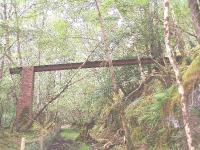
John Gray 28/07/2005
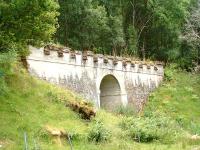
John Gray 28/07/2005
Dates are assumed.
...
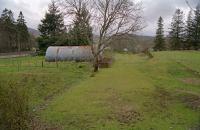
Ewan Crawford //2000
This was a three platform station. There was a through platform for the line to Fort Augustus Pier and two bay platforms. The platforms were in concrete, as were many structures of this line. The station building was reminiscent of the West Highland style, but at ninety degrees to the line.
...
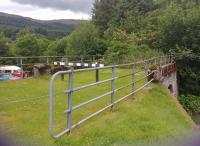
Alan Cormack 09/07/2017
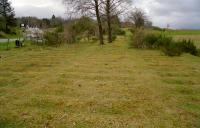
Ewan Crawford //2000
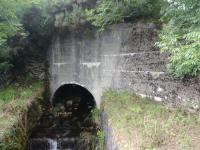
...
Alan Cormack 17/07/2017
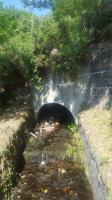
...
John Yellowlees 30/06/2018
This was a single track hand operated swing bridge immediately north of Fort Augustus station and its through platform on the west side of the station. The bridge pivoted at the south end.
...
See also
Caledonian Canal
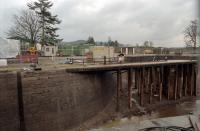
Ewan Crawford //1996

Ewan Crawford //
This was a single track lattice girder bridge with four spans and castellated piers. The line's engineers were Forman and McColl and the resident engineer was William Roberts, later of the Highland Railway.
...
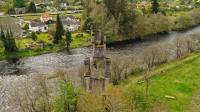
John Gray 07/05/2022
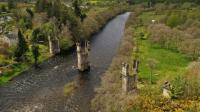
John Gray 07/05/2022
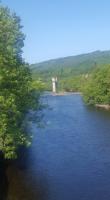
John Yellowlees 30/06/2018

Ewan Crawford //
This station was north of Fort Augustus station on the west side of Loch Ness.
...
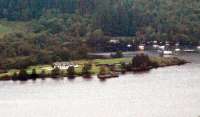
Ewan Crawford 21/09/2008










